Ultraviolet-Sensitive Properties of Graphene Nanofriction
Abstract
1. Research Background
2. Experimental
2.1. Preparation of Graphene Samples
2.2. Experimental Method of Friction
3. Results and Discussion
3.1. Tribological Characteristics under Short-Term UV Irradiation
3.2. Frictional Aging under Long-Term UV Vacuum Irradiation
4. Conclusions
Supplementary Materials
Author Contributions
Funding
Acknowledgments
Conflicts of Interest
References
- Patton, S.T.; Zabinski, J.S. Failure mechanisms of a MEMS actuator in very high vacuum. Tribol. Int. 2002, 35, 373–379. [Google Scholar] [CrossRef]
- Huang, X.; Yin, Z.; Wu, S.; Qi, X.; He, Q.; Zhang, Q.; Yan, Q.; Boey, F.; Zhang, H. Graphene-based materials: Synthesis, characterization, properties, and applications. Small 2011, 7, 1876–1902. [Google Scholar] [CrossRef] [PubMed]
- Dahlan, N.A.; Thiha, A.; Ibrahim, F.; Milić, L.; Muniandy, S.; Jamaluddin, N.F.; Petrović, B.; Kojić, S.; Stojanović, G. Role of Nanomaterials in the Fabrication of bioNEMS/MEMS for Biomedical Applications and towards Pioneering Food Waste Utilisation. Nanomaterials 2022, 12, 4025. [Google Scholar] [CrossRef]
- Zhang, B.; Zhang, S.; Xia, Y.; Yu, P.; Xu, Y.; Dong, Y.; Wei, Q.; Wang, J. High-Performance Room-Temperature NO2 Gas Sensor Based on Au-Loaded SnO2 Nanowires under UV Light Activation. Nanomaterials 2022, 12, 4062. [Google Scholar] [CrossRef] [PubMed]
- Zhang, H.; Lian, F.; Guan, G. Effect of UV irradiation on surface and friction properties of FOTS self-assembled molecular membranes. Tribology 2013, 33, 522–529. [Google Scholar] [CrossRef]
- Arranz-Mascarós, P.; Godino-Salido, M.L.; López-Garzón, R.; García-Gallarín, C.; Chamorro-Mena, I.; López-Garzón, F.J.; Fernández-García, E.; Gutiérrez-Valero, M.D. Non-covalent Functionalization of Graphene to Tune Its Band Gap and Stabilize Metal Nanoparticles on Its Surface. ACS Omega 2020, 5, 18849–18861. [Google Scholar] [CrossRef]
- Xin, G.; Wang, M.; Zhai, Y.; Zhang, B.; Song, J.; Liu, X. Functionalization of Self-supporting Graphene with a High Grafting Yield for Hydrophilicity Improvement. Chem. Lett. 2021, 50, 116–119. [Google Scholar] [CrossRef]
- Imamura, G.; Saiki, K. Modification of Graphene/SiO2 Interface by UV-Irradiation: Effect on Electrical Characteristics. ACS Appl. Mater. Interfaces 2015, 7, 2439–2443. [Google Scholar] [CrossRef]
- Iqbal, M.Z.; Siddique, S.; Iqbal, M.W.; Eom, J. Formation of p–n junction with stable p-doping in graphene field effect transistors using deep UV irradiation. J. Mater. Chem. C 2013, 1, 3078–3083. [Google Scholar] [CrossRef]
- Luo, Z.; Pinto, N.J.; Davila, Y.; Johnson, A.T.C. Controlled doping of graphene using ultraviolet irradiation. Appl. Phys. Lett. 2012, 100, 253108. [Google Scholar] [CrossRef]
- Walker, P.L.; McKinstry, H.A.; Wright, C.C. X-ray Diffraction Studies of a Graphitized Carbon—Changes in Interlayer Spacing and Binding Energy with Temperature. Ind. Eng. Chem. 1953, 45, 1711–1715. [Google Scholar] [CrossRef]
- Nemes-Incze, P.; Osváth, Z.; Kamarás, K.; Biró, L. Anomalies in thickness measurements of graphene and few layer graphite crystals by tapping mode atomic force microscopy. Carbon 2008, 46, 1435–1442. [Google Scholar] [CrossRef]
- Jain, A.; Bharadwaj, P.; Heeg, S.; Parzefall, M.; Taniguchi, T.; Watanabe, K.; Novotny, L. Minimizing residues and strain in 2D materials transferred from PDMS. Nanotechnology 2018, 29, 265203. [Google Scholar] [CrossRef] [PubMed]
- Zeng, X.; Peng, Y.; Lang, H. A novel approach to decrease friction of graphene. Carbon 2017, 118, 233–240. [Google Scholar] [CrossRef]
- DeRosa, R.L.; Schader, P.A.; Shelby, J.E. Hydrophilic nature of silicate glass surfaces as a function of exposure condition. J. Non-Cryst. Solids 2003, 331, 32–40. [Google Scholar] [CrossRef]
- Luo, G.; Hu, S.; Zhu, W. Enhanced UV absorption of graphene based on asymmetric resonant cavities. J. Opt. 2021, 41, 260–267. [Google Scholar]
- Lee, C.; Li, Q.; Kalb, W.; Liu, X.-Z.; Berger, H.; Carpick, R.W.; Hone, J. Frictional Characteristics of Atomically Thin Sheets. Science 2010, 328, 76–80. [Google Scholar] [CrossRef]
- Li, S.; Li, Q.; Carpick, R.W.; Gumbsch, P.; Liu, X.Z.; Ding, X.; Sun, J.; Li, J. The evolving quality of frictional contact with graphene. Nature 2016, 539, 541–545. [Google Scholar] [CrossRef]
- Choi, J.S.; Kim, J.S.; Byun, I.S.; Lee, D.H.; Lee, M.J.; Park, B.H.; Lee, C.; Yoon, D.; Cheong, H.; Lee, K.H.; et al. Friction anisotropy–driven domain imaging on exfoliated monolayer graphene. Science 2011, 333, 607–610. [Google Scholar] [CrossRef]
- Peng, Y.; Zeng, X.; Yu, K.; Lang, H. Deformation induced atomic-scale frictional characteristics of atomically thin two-dimensional materials. Carbon 2020, 163, 186–196. [Google Scholar] [CrossRef]
- Gonzalez, M.G.; Oliveros, E.; Wörner, M.; Braun, A.M. Vacuum-ultraviolet photolysis of aqueous reaction systems. J. Photo-Chem. Photobiol. C Photochem. Rev. 2004, 5, 225–246. [Google Scholar] [CrossRef]
- Zhou, L.; Zhang, L.M.; Liao, L.; Yang, M.M.; Xie, Q.; Peng, H.L.; Liu, Z.R.; Liu, Z.F. Photochemical modification of graphene. Acta Chim. Sin. 2014, 72, 289–300. [Google Scholar] [CrossRef][Green Version]
- Kato, R.; Hasegawa, M. Controlled defect formation and heteroatom doping in monolayer graphene using active oxygen species under ultraviolet irradiation. Carbon 2020, 171, 55–61. [Google Scholar] [CrossRef]
- Cao, A.; Shen, B.; Lin, Q.; Chen, S.; Huang, Z.; Ji, Z.; Zhang, Z. Influence of Stone-Wales defect on graphene friction: Pinning effect and wrinkle modification. Comput. Mater. Sci. 2019, 173, 109423. [Google Scholar] [CrossRef]
- Imamura, G.; Saiki, K. Interlayer Interaction in the UV Irradiated Defect Formation of Graphene. J. Phys. Chem. C 2014, 118, 11842–11848. [Google Scholar] [CrossRef]
- Mund, B.K.; Sturm, J.M.; van den Beld, W.T.E.; Lee, C.J.; Bijkerk, F. Etching processes of transferred and non-transferred multi-layer graphene in the presence of extreme UV, H2O and H2. Appl. Surf. Sci. 2020, 504, 144485. [Google Scholar] [CrossRef]
- Nair, R.R.; Blake, P.; Grigorenko, A.N.; Novoselov, K.S.; Booth, T.J.; Stauber, T.; Peres, N.M.; Geim, A.K. Fine structure constant defines visual transparency of graphene. Science 2008, 320, 1308. [Google Scholar] [CrossRef]
- Mak, K.F.; Sfeir, M.Y.; Wu, Y.; Lui, C.H.; Misewich, J.A.; Heinz, T.F. Measurement of the optical conductivity of graphene. Phys. Rev. Lett. 2008, 101, 196405. [Google Scholar] [CrossRef]
- Mak, K.F.; Shan, J.; Heinz, T.F. Seeing many-body effects in single-and few-layer graphene: Observation of two-dimensional saddlepoint excitons. Phys. Rev. Lett. 2011, 106, 046401. [Google Scholar] [CrossRef]
- Trevisanutto, P.E.; Holzmann, M.; Cote, M.; Olevano, V. Ab initio high-energy excitonic effects in graphite and graphene. Phys. Rev. B 2010, 81, 121405. [Google Scholar] [CrossRef]
- Yoshikawa, G.; Kiguchi, M.; Ueno, K.; Koma, A.; Saiki, K. Visible light photoemission and negative electron affinity of single-crystalline CsCl thin films. Surf. Sci. 2003, 544, 220–226. [Google Scholar] [CrossRef]
- Girifalco, L.A.; Hodak, M.; Lee, R.S. Carbon nanotubes, buckyballs, ropes, and a universal graphitic potential. Phys. Rev. B 2000, 62, 13104. [Google Scholar] [CrossRef]
- Maruyama, S. Molecular dynamics method for microscale heat transfer. In Advances in Numerical Heat Transfer; CRC Press: Boca Raton, FL, USA, 2018; pp. 189–226. [Google Scholar]
- Ong, Z.Y.; Pop, E. Molecular dynamics simulation of thermal boundary conductance between carbon nanotubes and SiO2. Phys. Rev. B 2010, 81, 155408. [Google Scholar] [CrossRef]
- Pang, H.; Wang, H.; Li, M.; Gao, C. Atomic-Scale Friction on Monovacancy-Defective Graphene and Single-Layer Molybdenum-Disulfide by Numerical Analysis. Nanomaterials 2020, 10, 87. [Google Scholar] [CrossRef]
- Wang, Y.; Li, Z.; Bi, K.; Yang, J.; Chen, Y. Influence of defects on friction properties of graphene-based on molecular dynamics. Tribology 2006, 36, 500–605. [Google Scholar]
- Tripathi, M.; Awaja, F.; Bizao, R.A.; Signetti, S.; Iacob, E.; Paolicelli, G.; Valeri, S.; Dalton, A.B.; Pugno, N.M. Friction and Adhesion of Different Structural Defects of Graphene. ACS Appl. Mater. Interfaces 2018, 10, 44614–44623. [Google Scholar] [CrossRef]

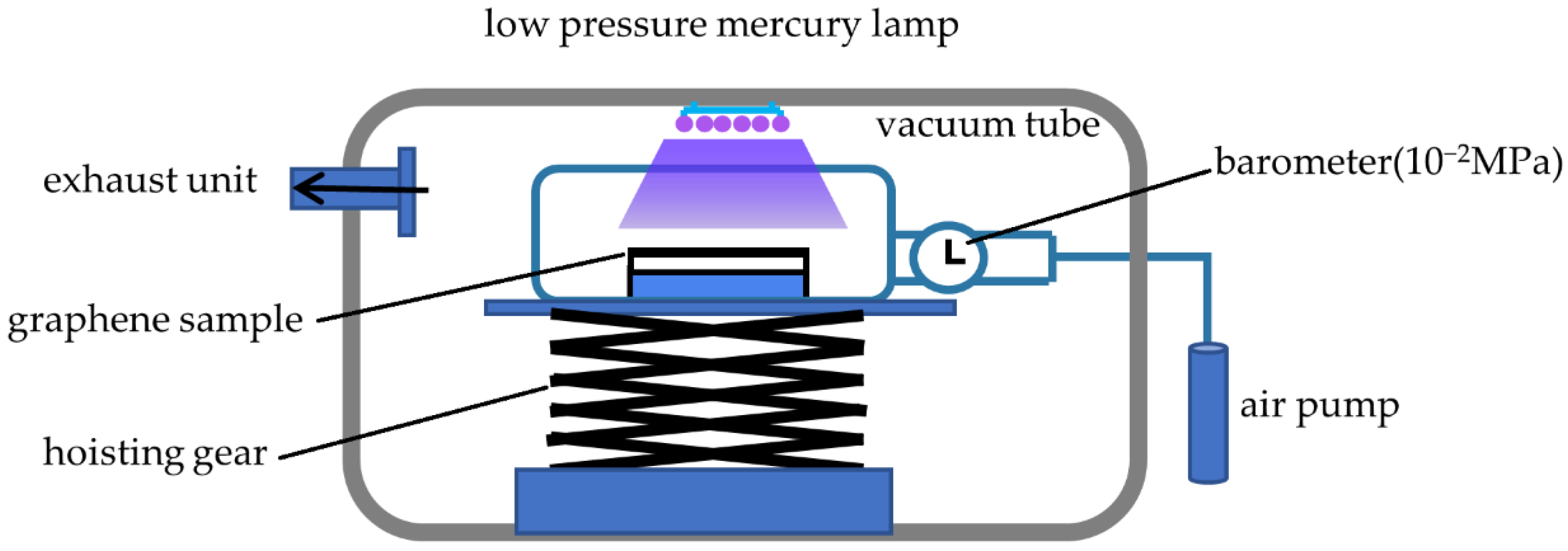
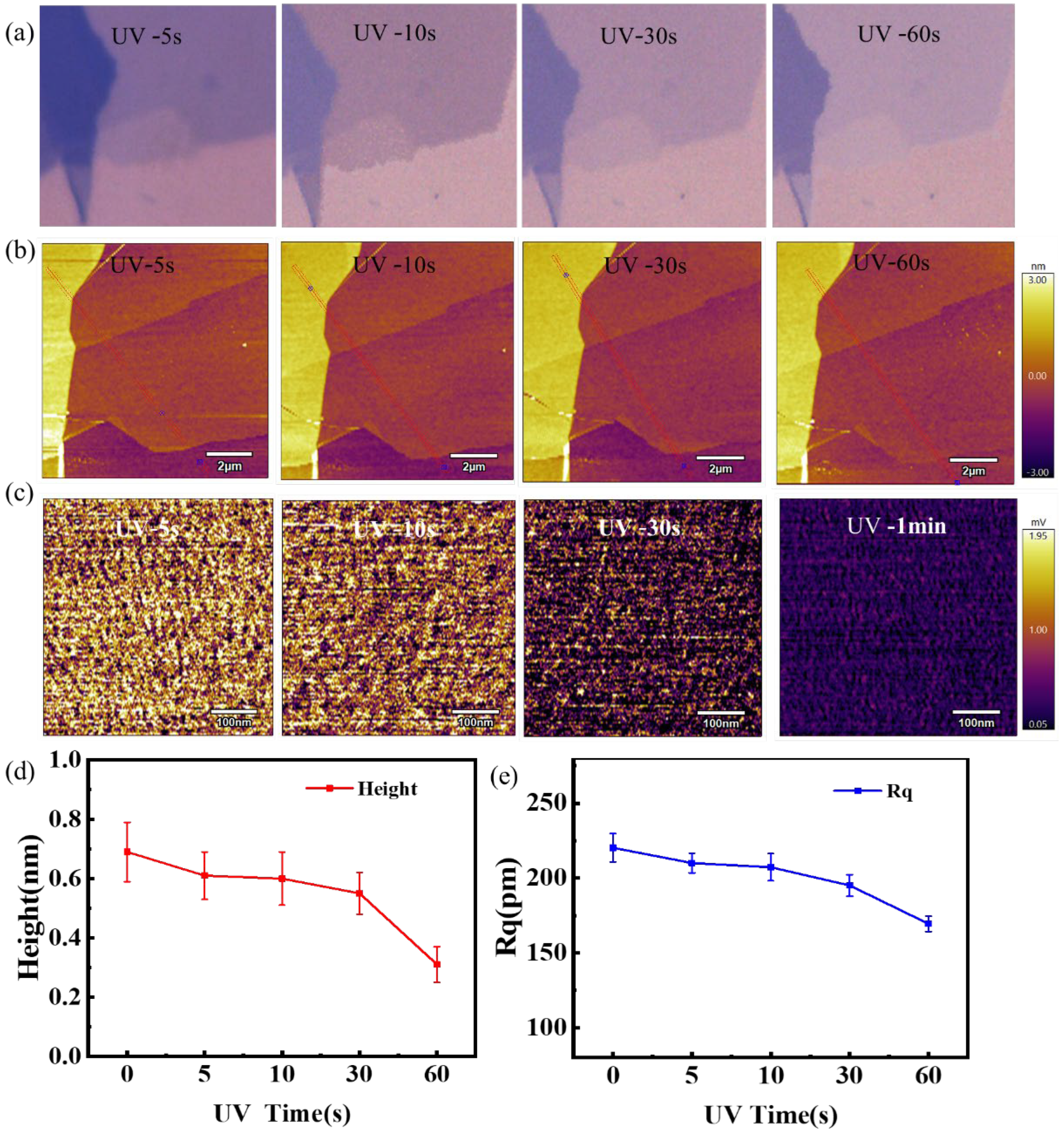
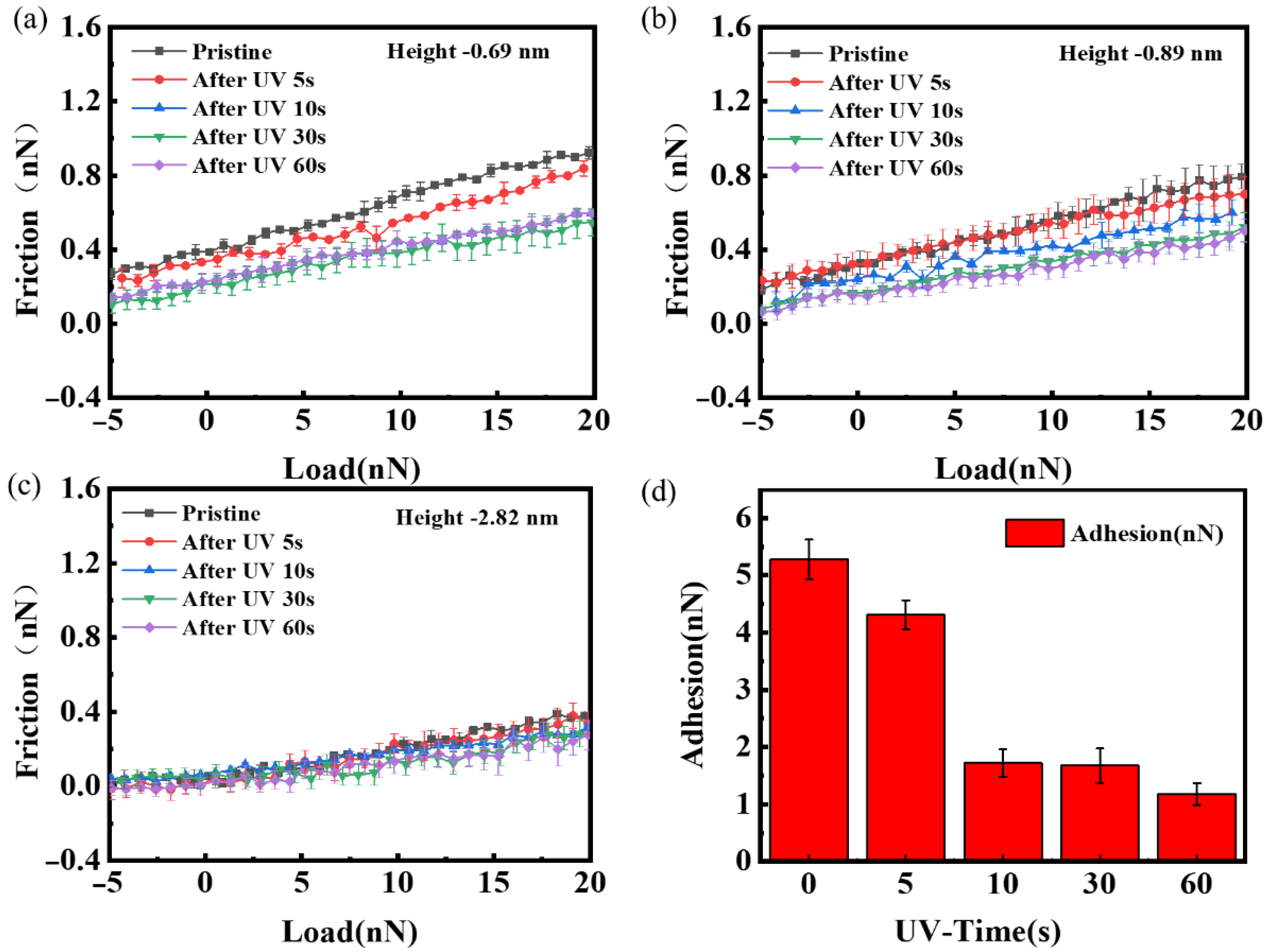
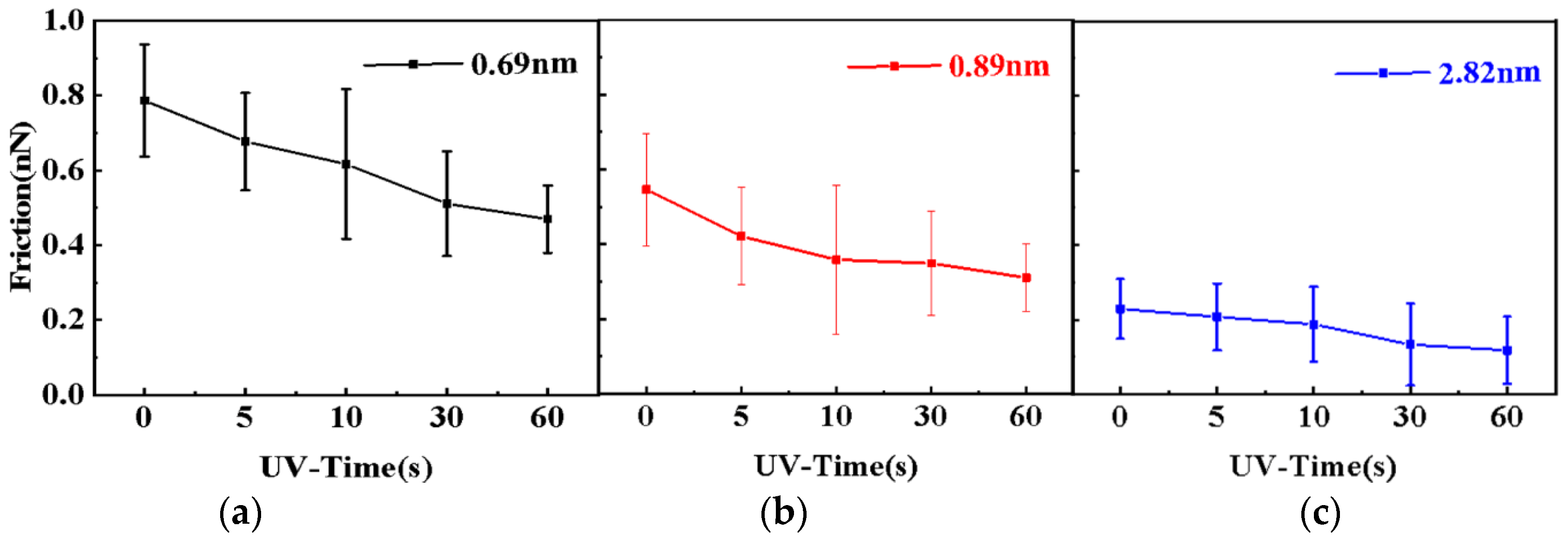
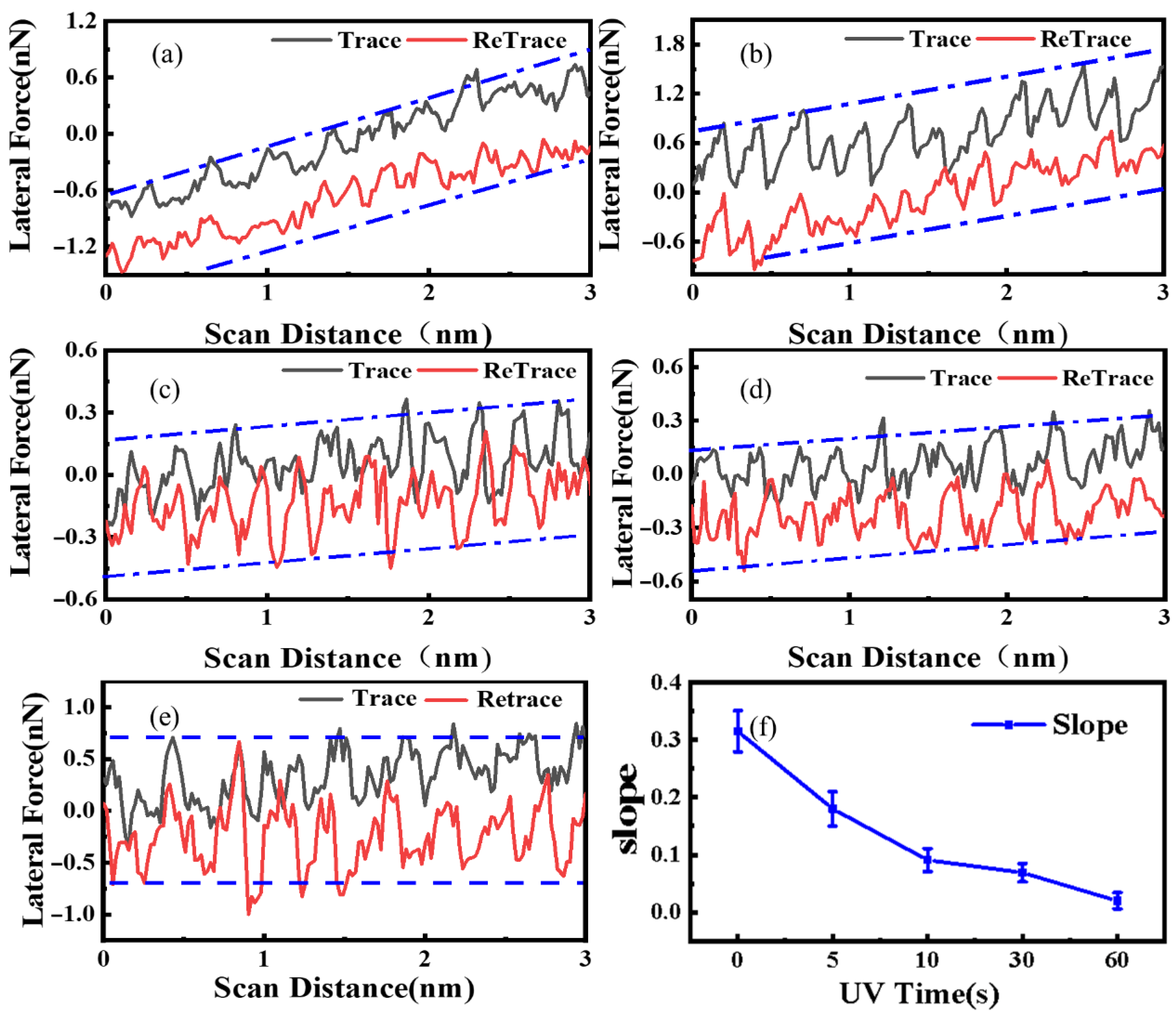
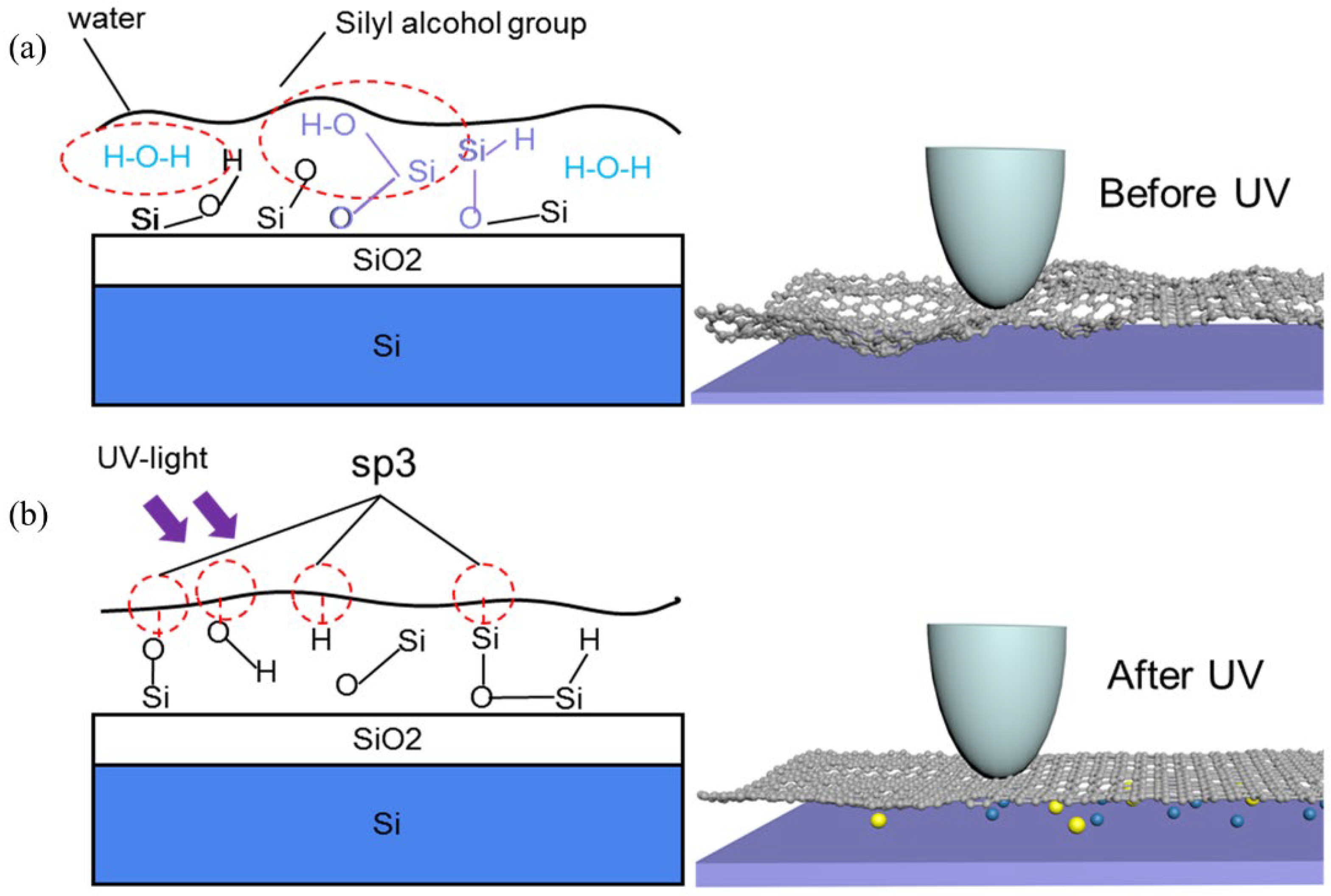

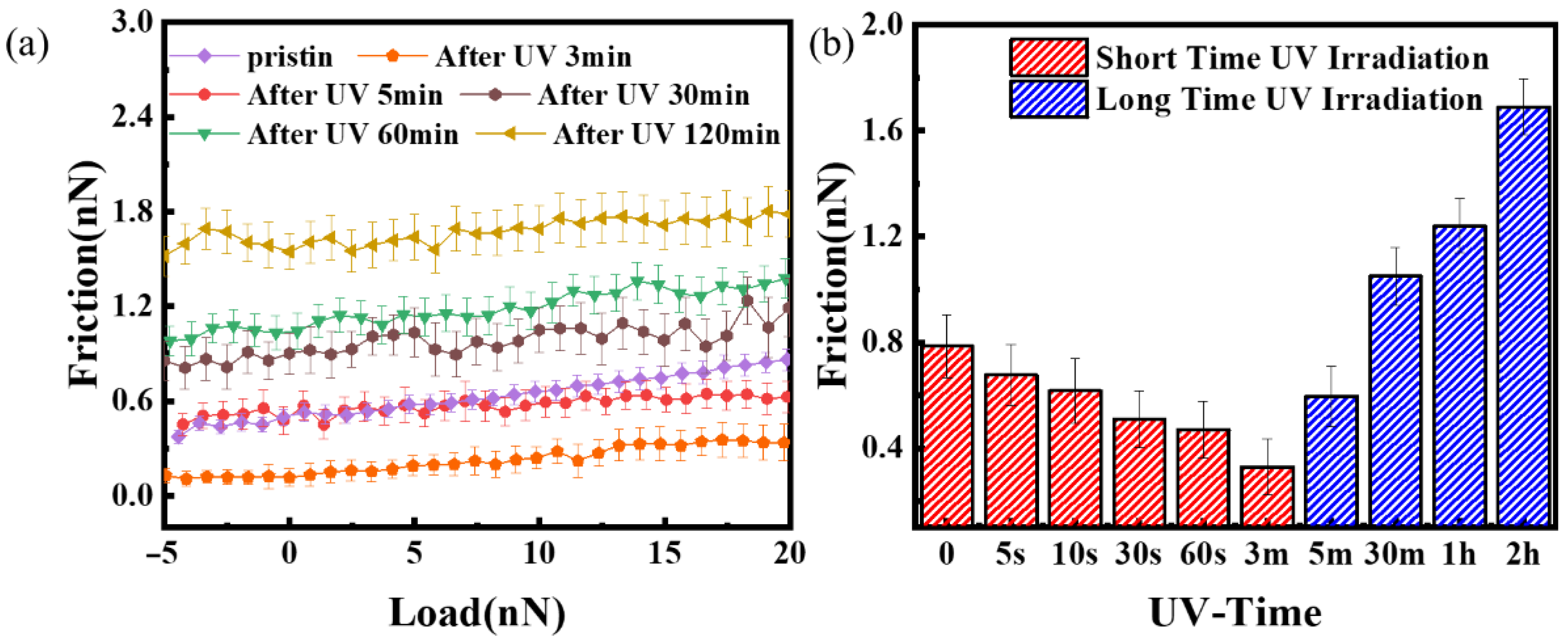
| Tube Type | Special Lattice Lamp Tube (Imported Quartz Material), 250 W |
|---|---|
| Work spectrum | 185 nm + 254 nm |
| Effective power density | 26~30 mW/cm2 |
| Distance between sample and lamp tube | 100 mm |
| Ozone exhaust system | III |
Publisher’s Note: MDPI stays neutral with regard to jurisdictional claims in published maps and institutional affiliations. |
© 2022 by the authors. Licensee MDPI, Basel, Switzerland. This article is an open access article distributed under the terms and conditions of the Creative Commons Attribution (CC BY) license (https://creativecommons.org/licenses/by/4.0/).
Share and Cite
Dong, G.; Ding, S.; Peng, Y. Ultraviolet-Sensitive Properties of Graphene Nanofriction. Nanomaterials 2022, 12, 4462. https://doi.org/10.3390/nano12244462
Dong G, Ding S, Peng Y. Ultraviolet-Sensitive Properties of Graphene Nanofriction. Nanomaterials. 2022; 12(24):4462. https://doi.org/10.3390/nano12244462
Chicago/Turabian StyleDong, Gaolong, Shuyang Ding, and Yitian Peng. 2022. "Ultraviolet-Sensitive Properties of Graphene Nanofriction" Nanomaterials 12, no. 24: 4462. https://doi.org/10.3390/nano12244462
APA StyleDong, G., Ding, S., & Peng, Y. (2022). Ultraviolet-Sensitive Properties of Graphene Nanofriction. Nanomaterials, 12(24), 4462. https://doi.org/10.3390/nano12244462







